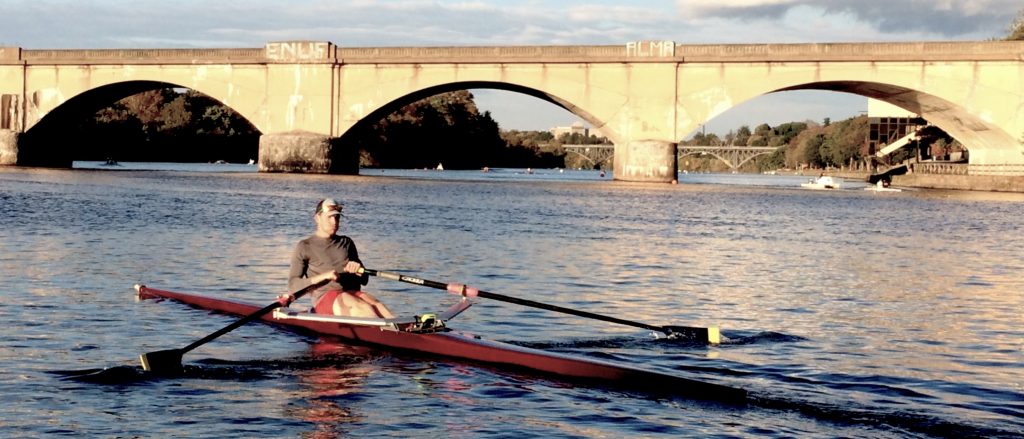
Rower in a single scull on the Schuylkill River below Columbia Bridge
The working title for the project had been River of Champions, but a Philadelphia curator wisely cautioned that it sounded a bit too much like a breakfast cereal. A longtime member of the University Barge Club shared the acronym OTW, which in the parlance of the amateur rowing community, means “on the water”. The expression signifies more than just getting into ones scull. It denotes the three-mile stretch of unbroken water that flows from East Falls to the Boathouse Row. The river was known to the indigenous Lenni-Lenape as Tulpehanna, or “turtle river”.
When Dutch explorers in 1616 failed at first to discover its confluence with the Delaware (Lenapewihittuck), concealed behind a barrier of wooded islands, they named it Schuylkill, or “hidden creek”. They had not idea that its watershed rose in the foothills of the Alleghenies, 135 miles to the northwest.
The sport of crew and single scull rowing began during the colonial period, when ferry-men carrying goods and people from ship to shore began to organize races to test their skills in competition. This was nothing new in 18th-century Philadelphia. Barge-men on the River Thames had been racing for centuries, as had gondolieri in the Regatta di Venezia.

Giovanni Antonio Canal (1697-1768), detto Canaletto. Regatta on the Grand Canal. 1740. National gallery, London.
With the completion of the Fairmount dam in 1821, a body flat water stretching upstream afforded rowing enthusiasts the perfect venue for their sport, free of tides, shoals and sawyers. The first oarsmen on the Schuylkill were tradesmen and members of the working class. After the first regatta in 1835 rowing began to attract athletes from all walks of life.

Nicolino Calyo. The First Schuylkill Regatta. Gouache on paper. 1835.
Twenty-three years later the Schuylkill Navy was formed, as an umbrella organization for all the barge-clubs, a governing body to vet competitors and oversee regattas. Boathouse Row today has become familiar landmark, on the left bank of the river just above the dam.

Hydrographic Survey of the Schuylkill River. 1866
Few rowers venture upstream past Falls Bridge, three miles to the north, but there are stretches of the river where one can find oarsmen and women on the water. A rowing center exists along the flat water below Conshohocken, in Montgomery County. A few stalwart souls will launch their boats in the tidal estuary at Forgotten Bottom, below Grey’s Ferry, near Bartram’s Garden.

William Bartram (1739-1823). Zoological studies. Natural History Museum, London.
Following the success of Hudson Highlands, as the next volume of North River Suite goes into production, I now embark on a new project that celebrates another river.
Made famous by William Birch and Thomas Eakins, the Schuylkill has for nearly two centuries been the heartbeat of amateur rowing in America. Last year’s exhibition at Independence Seaport Museum “Breaking Barriers” corrected the misperception that rowing is a sport reserved for elites, by revealing how amateur rowing today promotes diversity, inclusivity, health and community.
 Facebook
Facebook Twitter
Twitter Linkedin
Linkedin